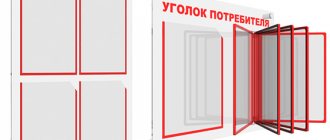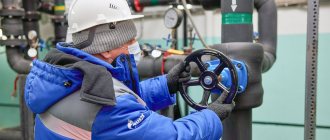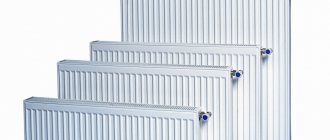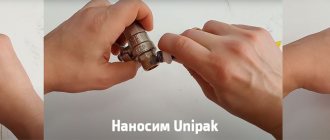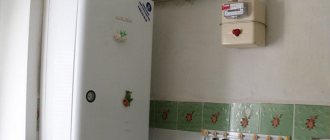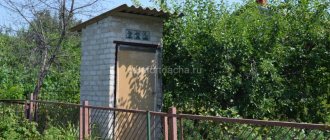Many modern residential apartments are equipped with autonomous heating. There is no question of norms here. Everyone sets the water temperature in the radiators as desired and pays according to the meter. However, most houses still have central heating, where the temperature in the radiators is regulated by regulations. When it gets cold in the apartment, people wonder what the normal temperature of the water in the central heating radiators is.
Radiators according to GOST standards
Fight for warmth
It is better to think about possible heat loss in your home in the summer. But if this has not been done, then it is possible to insulate the house with the onset of winter. The first thing to do is to identify weak points where heat loss is possible.
Windows according to standards
The main source of cold is windows. Nowadays there are double-glazed windows above heating radiators and radiators almost everywhere. But even plastic window frames age. The sealing rubber becomes unusable.
Central heating in the apartment
The windows begin to let in the cold. The easiest way is to stretch plastic film over the frames. It is sold in stores in rolls. This material does not have any effect on the transparency of the glass. Heat loss in radiators or radiators will be reduced.
The film is fixed to the glass. Before this, the frames are thoroughly washed. Double-sided tape is applied around the perimeter. A film is attached to it. It's easier to do this together.
Battery on the wall
If wrinkles have formed on the coating, heat the film with a hairdryer until they straighten out. Then all that remains is to seal the frames. They do this with single-sided tape. Such a simple method helps to retain up to 20% of heat.
Every morning you should open the curtains and raise the blinds. The apartment is perfectly warmed by sunlight penetrating into the room through the glass. Double glass frames create a magnifying effect, enhancing the warmth of sunlight. When it gets dark, the windows should be closed. At night, glass draws heat out of the room.
Radiator under the central window
Batteries according to standards
The batteries are located along the walls. Dank damp partitions take away heat. A simple reflector will help avoid this. A reflector is not a technical device. This is simply a sheet of foil attached to a radiator or radiator.
The reflector sheet is made slightly larger than the area occupied by the radiator or radiator. A homemade reflector will raise the room temperature by at least 2 degrees.
Porilex and penofol have lower thermal conductivity than foil. This is facilitated by the insulation layer they have.
Heating batteries
It is necessary to require compliance with water standards in heating devices from utility services. But the comfort in the house cannot be left only to the mercy of the management company. It is always safer to take care of the microclimate in your home yourself.
When heat depends on batteries
The heat supply is regulated by Decree of the Government of the Russian Federation No. 354 of May 6, 2011. According to this document, the start and end of heating is tied to the ambient temperature. The central heating radiators are turned on when the daily average drops 8 degrees above zero and lasts for five days. On the main territory of Russia this occurs by mid-October.
Battery under the window
Water leaves radiators when the average outdoor temperature reaches +8 degrees Celsius. And it remains so for five days. Battery shutdown times vary according to regulations.
In warm years this occurs at the end of April.
If the temperature is low, then according to the standards, heating of residential and industrial premises is maintained until mid-May. Only during this period of time should we talk about temperature standards for water in radiators. The rest of the time, fighting the cold is the job of the residents.
Temperature of heating radiators in the apartment standards
Apartment heating standards determine the specific value of a sufficient indicator for residential and non-residential premises, with permissible deviations from their indicators.
They are developed more simply than for work premises, since those living in the housing exhibit low and, at the same time, stable activity:
- For residential premises, the air temperature is from 20 to 22 degrees Celsius, while acceptable limits are considered to be from 18 to 24 degrees;
- If we take corner rooms, then the indicator should not be less than twenty degrees, since such rooms are more susceptible than others to low external temperatures and winds;
Temperature conditions in various rooms and their standards
Although the standards for apartments in apartment buildings are determined by regulatory documents, they differ somewhat depending on the location of the dwelling in the building structure. Thus, the heat standard in a corner apartment in winter, which is exposed to frost and wind more than other rooms, ranges from +20 °C.
Inside the apartment, different temperature standards also apply for different rooms, depending on their purpose. Thus, GOST establishes the following permissible and optimal values for:
- living rooms - 18 °C (20-22);
- kitchens - 20°C (22-23);
- combined toilets and bathrooms - 18 °C (24-26);
- toilets - 18 °C (19-21);
- premises for study and recreation - 18 °C (20-22);
- pantries - 14 °C (16-18);
- inter-apartment corridors - 16 °C (18-20);
- staircases, lobbies -12°C (16-18).
According to the same GOST, from 24:00 to 5:00 in residential premises the temperature can be reduced by 3°C.
Air ratio parameters
The room must have a certain air exchange rate, for example, if the room is residential and has an area of 18 or 20 m2, then the rate should be 3 m3/h per square meter. m., the same parameters are also necessary in regions where the temperature reaches −31°C and drops below. In dormitory kitchens and apartments equipped with electric and gas two-burner stoves and having an area of up to 18 m2, aeration is 60 m3/h. If there is a three-burner appliance in the room, then this value will be 75 m3/h, if there is a gas stove with four burners - 90 m3/h. For a bathroom with an area of 25 m2, the air exchange rate should be 25 m3/h, and for an individual restroom with an area of 18 m2 - 25 m3/h. If the bathtub and toilet are combined and their area is 25 m2, then the aeration is 50 m3/h. If the common restroom has an area of 16 m2, then an air exchange rate of up to 50 m3/h is required for one toilet, and 25 m3/h for a urinal. If the room is corner, then the room should be 2°C higher than usual. During warm periods, the temperature in the elevator room should not exceed 40°C.
Pyrometer and how to work with it
A pyrometer is an infrared thermometer. It determines temperature by electromagnetic radiation. An accurate engineering device allows you to quickly measure the temperature of an object located at a distance not exceeding three meters from the device.
Heating standards
But even this excellent equipment is capable of producing errors, which is what negligent utility workers take advantage of. When measuring temperature, the device readings will be erroneous if:
- in a relatively small room there are many objects made from various materials;
- there is high humidity or a lot of dust in the room;
- the temperature of the device differs significantly from the room temperature;
- the distance to the measured object exceeds 3 m;
- the room is very large.
Requirements for heating networks
With centralized heat supply, the heat source is a boiler house or a thermal power plant, where high-temperature water-heating boilers are installed (in thermal power plants - steam boilers). The fuel is usually natural gas, with other energy sources being used to a lesser extent. The temperature of the coolant at the outlet of the hot water boiler is 115 °C, but the water does not boil when it is under pressure. The need to heat up to 115 °C is explained by the fact that boiler plants operate at maximum efficiency in this mode. The transition from 115 °C to the required temperature value is provided by plate or shell-and-tube heat exchangers. At a thermal power plant, waste steam from turbines enters heat exchangers to produce electricity. According to regulatory requirements, the water temperature in heating pipes should not exceed 105 ° C, the lower limit depends on street conditions. In this range, the heating of water in the heating network is regulated depending on the weather, for which each boiler room has a temperature graph of the heating system. For home networks, 2 calculation schedules are used: 105/70 °C; 95/70 °C.
These figures show the maximum temperature of the supply and return water during the most severe frosts in a particular area. But at the beginning and end of the heating season, when the weather is not yet too cold, there is no point in heating the coolant to 105 °C, so a real temperature heating schedule is drawn up, which describes to what extent the water should be heated at different outside temperatures. The dependence of heating on weather conditions is shown in the table, which presents excerpts from the graph for the city of Ufa: Average daily street air temperature, °C at the supply with a design schedule of 105/70 at the supply with a design schedule of 95/70 in the return +8 43 41 36 56 52 43 -5 64 59 48 -10 71 65 52 -15 78 72 56 -20 85 78 59 -25 92 84 63 -30 99 89 67 -35 105 95 70
The table is presented as an example and is correct only for this city; another locality has its own dependence, because the climatic conditions in the country are different. It is quite difficult to find out exactly what the coolant temperature is in a centralized heating network. To do this, you need to have a remote thermometer that determines the degree of surface heating. So, it is possible to determine to what extent the heating standards in the apartment are met only by the air temperature in the rooms.
Measurement
If apartment residents have doubts about the quality work of the heat supply company and the room is very cold, it is necessary to establish the cause of the poorly heated radiators. First of all, you will need to measure the temperature of the pipes, radiator, air in the room and the water itself in the heating system.
It must be borne in mind that self-conducted measurements cannot be presented as evidence of violation of standards. But based on them, you can file a complaint and subsequently invite employees of the service company for control measurements.
Temperature measurement techniques
An ordinary household thermometer on the surface of a heating device. A device designed to measure temperature in a non-contact manner. Such a meter is called -
. Alcohol thermometer. A special electrical device. If you take measurements with an ordinary thermometer, you will need to add a few more degrees to the indicators. The most accurate readings can be obtained using an infrared device - a pyrometer. Its error is no more than 0.5 degrees. To regularly monitor temperature, use only the safest device - an alcohol thermometer. For these purposes, it is attached to the radiator using tape and wrapped in thermal insulation material. How to use the electric version of the thermometer? You need to take a wire with a thermocouple and attach it to the heating device. This is how the indicators are taken. If a commission comes to your apartment to measure the temperature of the batteries, they must have a certified device. You have the right to demand from a representative of the inspecting organization documents confirming that the equipment has passed state verification. Very serious requirements are imposed on the heating system. The process of delivering hot coolant using circulation pumps (the installation rules for the heating system are written here) to a residential building and its uniform distribution throughout all apartments is not an easy task. This issue must be approached responsibly, and with an understanding of all the technological subtleties. In order for the heating system to work efficiently, all its elements must function harmoniously. This applies to all pipes and radiators in each of the apartments of a multi-story building. Therefore, when replacing radiators (read how to install heating radiators in a private house in this article), you need to take into account the features and subtleties of the heating main. If this is not done, some apartments will experience an excess of heat, while bad times will come for the residents of other apartments (they will have cold radiators). How can the heating of urban dwellings be optimized? Answer: by introducing the following standards: the safety regulations state that the temperature of the working liquid substance in the heating main must be 20 degrees less than the temperature of self-igniting materials. For residential multi-apartment buildings, the coolant limit has established standards - 65 - 115 degrees Celsius (this takes into account seasonality); if the water, for some reason, overheats and reaches a reading of 105 degrees, emergency measures must be taken to prevent it from boiling; the standard limit for water circulating through the batteries is 75 degrees. In case this indicator is exceeded by the battery needs to install a restrictive structure (about methods of heating in a private house is written here); in regions located in the middle latitudes of our country, the heating season, as a rule, begins on the fifteenth of October and ends on the fifteenth of April. In some cases, these standards may be changed. Service providers should rely on the average daily outdoor temperature.
Warm water supply
The coolant is the water that we are so accustomed to turning on every day in our bathroom.
As one way to check what temperature the water is, you can simply insert a thermometer under the stream. If within fifty to seventy degrees Celsius, this is the norm; deviations can also be a maximum of four degrees.
It is worth remembering that each device has its own deviation scale, so when the result is obtained, you need to add one or two degrees.
The apartment is cold, why complain?
Before you go looking for heat, you should remember that heat in the room will be supplied through the heating system only when the outside temperature reaches a certain level.
Standards require heating to start when the outside temperature is no more than 8 degrees. This temperature indicator must last for five days in a row, and only after this the rooms will begin to be heated.
When the heating in the house is adjusted, and temperature deviations are observed only in your room, it is necessary to check the indoor heating system for airing.
It is enough to feel the individual batteries in the apartment from top to bottom, and back. If some of the batteries are noticeably warm and the rest are cold, you can be sure that airing is the cause of the thermal imbalance. The air is released using a separate tap, which is located on each radiator battery.
Before opening the tap, you should place some container under it. When you open the tap, water should come out of it with a characteristic hissing sound. If the water begins to flow smoothly and without hissing, it means that the air has been released from the system, and the job is done.
After this, you should fix the tap in the closed position. After a while, check the cold spots on the battery, they should warm up.
If the problem is not with the batteries and they are completely cold, you should contact the management company. The technician will arrive within 24 hours. He will be able to draw a conclusion about the temperature conditions in the home and, if necessary, call a team that will fix all the problems.
When the management company did not respond to your appeal or the appearance of a technician did not change the situation, you should take temperature measurements in your home yourself, calling your neighbors.
When you have a device such as a pyrometer at your disposal, you should use it to take the necessary temperature measurements. Record all data in a report on measuring the air temperature in your home. It is compiled in the usual form. Let the neighbors sign the act.
You should pay attention to the fact that the temperature regime is determined by the “Sanitary and Epidemiological Requirements for Residential Buildings and Premises” SanPiN 2.1.2.1002-00. Recorded measurements should be compared with the limit values specified in SanPiN
Then you need to go back to the management company and the organization that supplies the house with heat to write a written complaint
Recorded measurements should be compared with the limit values specified in SanPiN. Then you need to go back to the management company and the organization that supplies the house with heat to write a written complaint.
The document is drawn up in two copies. One of the copies must be in your hands with a stamp, signed indicating the details of the person who accepted the document and the date of receipt of the document. The second one must be submitted for consideration.
If you were not satisfied with the answer, then there is no need to leave everything halfway, move on. You should contact the district Prosecutor's Office and the Housing Inspectorate, since it is she who is authorized to monitor the work of the management company and other communal structures.
Also write a letter to Rospotrebnadzor (based on the violation of your consumer rights). You can use the Rospotrebnadzor hotline (8-80-010-000-04).
Dear readers!
If you want to know, Or call us at:
8 ext. 214 Federal number (free call for all regions of Russia)!
Was the Recording helpful? Yes No 49 out of 67 readers found this post helpful.
How to find out which management company services a house
You can find the phone number of the management company on your utility receipt or on information signs at the entrance. Also clarify information about the service provider using the GIS Housing and Public Utilities service. To do this you need:
- Go on the website.
- In electronic services, click the “Find on map” tab.
- Enter your home address.
- The page will contain information about the method of managing an apartment building.
- After choosing a management company, you can clarify information about the organization, operating hours, address and telephone number.
Heating problems can also be solved through the emergency dispatch service in the region of residence.
Strict recording of temperature standards for heating radiators in an apartment is important
Knowing the room temperature standards will help you detect a malfunction and contact the appropriate authority for a solution.
Temperature indicators are regulated by GOST and SNiP standards.
ontakte
Odnoklassniki
The main indicator is indicated in document number 51617-2000. In accordance with it, the temperature should be:
- on a flight of stairs - 14-20 degrees;
- in the lobby and corridors - 16-22;
- in hallways, living rooms and other rooms of the apartment - 18-25;
- in the bathroom - about 24.
The temperature is more precisely regulated by GOST 30494-2011:
| Season | Room | Recommended value +/- 1 |
| Cold | Residential | 21 |
| Residential, in the north | 22 | |
| Kitchen | 20 | |
| Toilet | 20 | |
| Bathroom | 25 | |
| Inter-apartment corridor | 19 | |
| Children's | 24 | |
| Warm | Any | 23 |
Minimum indicators
Heating rooms is important at any time of the year, but especially in winter.
The heating system has typical temperature values that must be observed.
For each room there is a small interval presented in the table above. There is no minimum threshold as such.
But there are several indicators, a drop below which indicates a malfunction. This applies to heating premises: the law allows the temperature to drop to 12, 8 and even 4 degrees, but only for a short period of time - 16, 8 and 4 hours, respectively.
Maximum water temperature in radiators
SNiP 41-01-2003 establishes temperature limits from above: for piping from one pipe, heating of the coolant is allowed to 115 degrees, from two - up to 95°C. Despite the permitted values, they rarely exceed 80-85°C.
Attention! These rules apply to indoor parts of the heating system
Parameters by which central heating in the house is turned on
The Decree of the Government of the Russian Federation characterizes the need to turn on the heating at an average street temperature of +8°C or less. When heating, the temperature is measured at +5°C or more. Both values must last for at least 5 days in a row.
How to adjust and increase heat transfer
To change the temperature of heating radiators, it is necessary to install special regulators on them. There are 4 types of such devices: regulators with a locking mechanism, manually controlled valves, thermostats with automatic settings, radiator thermostats.
Photo 2. Manual thermostat for a radiator. By turning the knob you can set the desired temperature.
In order to increase the temperature of the radiator, it is necessary to open the regulator and let more coolant into the heating device. And, conversely, to lower the temperature, it is necessary to drain excess coolant.
What to do if there is no heating and a radiator malfunction
After detecting a problem, it is necessary to draw up a report indicating the unacceptably low temperature in the room. They contact the organization that supplies heat. The statement indicates the period during which the problem has been observed and the actual thermometer values. Based on the information, an inspection is carried out, compensation is calculated and a decision is made.
By law, during the heating season there can be a break of no more than 24 hours per month. The following conditions correspond to this: the temperature cannot fall below 12 degrees, and the shutdown should not last 16 hours in a row.
Important! There are two exceptions: the room can be 8-12 degrees for up to 8 hours in a row, or from 4 to 8, but no more than 4. Watch the video, which talks about what heating standards should be in an apartment
Watch a video that talks about what heating standards should be in an apartment.
Knowledge of SNiP and GOST standards will help to detect the problem, solve it and receive compensation for failure to fulfill obligations by the supplier.
Rate this article:
Be first!
Average rating: 0 out of 5. Rated by: 0 readers.
ontakte
Odnoklassniki
How everything works
There are two different types of charts:
- For heating networks.
- For indoor heating system.
The relationship between supply temperatures in the route and in the house.
To explain the difference between these concepts, it is probably worth starting with a brief excursion into how central heating works.
CHP - heating networks
The function of this bundle is to heat the coolant and deliver it to the end user. The length of heating mains is usually measured in kilometers, the total surface area is measured in thousands and thousands of square meters. Despite measures to insulate pipes, heat loss is inevitable: after traveling from the thermal power plant or boiler room to the border of the house, process water will have time to partially cool.
Hence the conclusion: in order for it to reach the consumer while maintaining an acceptable temperature, the supply of the heating main at the exit from the thermal power plant must be as hot as possible. The limiting factor is the boiling point; however, as the pressure increases, it shifts towards increasing temperature:
| Pressure, atmosphere | Boiling point, degrees Celsius |
| 1 | 100 |
| 1,5 | 110 |
| 2 | 119 |
| 2,5 | 127 |
| 3 | 132 |
| 4 | 142 |
| 5 | 151 |
| 6 | 158 |
| 7 | 164 |
| 8 | 169 |
Typical pressure in the supply pipeline of a heating main is 7-8 atmospheres. This value, even taking into account pressure losses during transportation, allows you to start a heating system in buildings up to 16 floors high without additional pumps. At the same time, it is safe for routes, risers and connections, mixer hoses and other elements of heating and hot water systems.
Inside the flexible hoses of the mixer the pressure is the same as in the heating main.
With some margin, the upper limit of the supply temperature is taken to be 150 degrees. The most typical heating temperature curves for heating mains are in the range of 150/70 – 105/70 (supply and return temperatures).
House
There are a number of additional limiting factors in a home heating system.
The maximum coolant temperature in it cannot exceed 95 C for a two-pipe and 105 C for a single-pipe building heating system.
A row of heating radiators stretches along the walls.
For obvious reasons, the temperature delta between the supply and return pipelines should be as small as possible - otherwise the temperature of the batteries in the building will vary greatly. This implies rapid circulation of the coolant. However, too fast circulation through the house heating system will lead to the return water returning to the route at an excessively high temperature, which is unacceptable due to a number of technical limitations in the operation of thermal power plants.
The problem is solved by installing one or more elevator units in each house, in which return water is mixed with the flow of water from the supply pipeline. The resulting mixture, in fact, ensures rapid circulation of a large volume of coolant without overheating the return pipeline of the route.
Elevator operation diagram.
For intra-house networks, a separate temperature schedule is set taking into account the elevator operation scheme. For two-pipe circuits, the typical heating temperature curve is 95-70, for single-pipe circuits (which, however, is rare in apartment buildings) - 105-70.
Methods for measuring water in radiators
When considering the question of how to measure the temperature of a battery in an apartment, the following methods can be distinguished:
- an ordinary thermometer (on the surface of the radiator);
- infrared thermometer;
- alcohol thermometer;
- special electrical device.
When measuring with a regular thermometer, you need to add 1-2 degrees to the result. A more accurate result will be given by an infrared device, the error of which is 0.5 degrees.
In order to regularly monitor the temperature of the water in the batteries, you can use an alcohol thermometer. To do this, the device is attached with tape to the radiator and wrapped in heat-insulating material.
The battery may not heat up evenly.
You can also use an electric version of the thermometer for measurements. To do this, a wire with a thermocouple is wound to the battery, and it takes readings of the degree of heating. If a consumer calls a special commission to measure the temperature of heating radiators in an apartment, then their device must have a quality certificate and first pass state inspection. The actions of specialists must comply with GOST 30494-96 (clause 4 in the “Control methods” section).
If the temperature of the heating pipes in the apartment is higher than normal, then it can be adjusted in several ways:
- using special devices;
- ventilation;
- using thick curtains.
There are special taps with which you can regulate the temperature. They are installed on each radiator. A simpler method is to ventilate the room. You can also simply use curtains made of dense material, which will let less sunlight into the room. It is much easier to deal with high room temperatures than low ones. What to do if the minimum temperature of the batteries in the apartment is lower than indicated in the temperature chart? To do this you should:
- call utility services;
- insulate windows, doors and walls;
- install new radiators.
If you don’t know how to check the temperature of the batteries in the apartment, you can call specialists. Also read: “Blowing and cleaning batteries.”
Utility services measure plumbing and heating systems. After this, an act is drawn up. Then, if the tenant's claims are confirmed, utility companies must increase or decrease water heating. Another way would be to install new heating radiators. Details about the installation can be found in the video:
You should pay attention to the material from which the batteries are made. Aluminum radiators have high thermal conductivity, so they will transfer heat well
But cast iron, although they are able to retain heat longer, will release it more slowly. Because of this, the room will take a long time to warm up.
Aluminum radiators have high thermal conductivity, so they will transfer heat well. But cast iron, although they are able to retain heat longer, will release it more slowly. Because of this, the room will take a long time to warm up.
The speed of water movement also affects the temperature in the heating pipes in apartments. Don’t forget that corner apartments are always cooler, because they have more walls in contact with the street. To reduce heat loss, it is necessary to insulate the walls. Insulating windows and doors through which cold air enters will also not be superfluous.
You can read more about infrared heating and energy consumption in this article.
What determines the weather in your home?
Modern equipment allows you to maintain hot water supply standards to heating radiators without much human intervention. But the number on the device is one thing, but the actual heat in the apartment is completely different. The final result depends on many parameters:
- The climate of the area where you live. In Moscow, with its drier climate, the cold is felt less than in St. Petersburg with its dampness.
- Thermal conductivity of the structure. Houses built of brick have lower thermal conductivity than block houses. As a result, the temperature of the water in the heating radiators may be lower due to less heat loss.
- Location of the apartment in the house. Corner rooms freeze more than apartments located in the center of the house. Heat loss in heating radiators will be greater.
- Decoration Materials. Walls covered with heat-saving wallpaper retain heat longer. This reduces heat loss from radiators and central heating radiators.
- Heating radiator material. Cast iron batteries give off less heat than steel ones.
Standard temperature in external networks
All these indicators will affect the atmosphere in the house regardless of heating temperature standards. It also doesn’t matter how hot the radiators or radiators in the apartment are.
Norm for an apartment
What temperature should the heating radiators of an apartment building be? It is useful to know that each room has its own heating standard in an apartment building (2017). Heating standards in apartment buildings 2021: for a living room it is +18; Heating standards in corner apartments due to the presence of external cold walls are higher - +20 degrees; for the kitchen +18; bathroom - +25. This applies to apartments, while for common areas the indicators are as follows: in the entrance - +16; for an elevator it is +5 degrees; in the basement and attic - +4. All measurements in the apartment must be carried out along the internal wall of the room at least 1 m from the nearest external wall and 1.5 m from the floor. If the obtained parameters do not comply with the standards, then they should be presented to the heating network management. In this case, payment may be reduced by 0.15% for each hour of deviation.
Parameters for turning on the heating
Heating is supplied in accordance with the standards prescribed in Decree No. 354 of 2011.
It contains information that heat is supplied to apartment buildings at an air temperature outside the window of +8°C, which persists for 5 days. If there are changes in temperature, the radiators will remain cold.
IMPORTANT! The heating is turned on only on the sixth day. Basically, in all regions, the heating season begins on October 15 and lasts until April 15.
Heat supply requirements
According to the above-mentioned Resolution, central heating is launched after 5 days, during which the average outside air temperature does not exceed +8 °C. If after 4 cold days it becomes warm again on the fifth, the start of the heating period is delayed until the specified conditions are met. Heating standards stipulate that stopping heating occurs according to the same principle: 5 days must pass with an average daily temperature of +8 °C.
The Decree contains changes that provide for an individual approach to the supply of heat to buildings that fully comply with the requirements for thermal insulation. Heating supply organizations are required to turn on the heating of such houses as soon as the outside temperature drops to the value specified in the design documentation. It is not difficult to guess that in reality these changes are not being carried out very well, and the start of heat supply occurs simultaneously in all residential buildings - insulated and ordinary. During the heating season, the centralized heating system must provide multi-apartment residential buildings with a sufficient amount of thermal energy. In order for the heat supply service to be considered fully provided, the following requirements for permissible air temperature in premises for various purposes must be met: living rooms - from 18 to 24 °C, corner rooms - from 20 °C; bathroom (or separate toilet and bathroom) - from 18 to 26 °C; kitchen (taking into account the heat source in the form of a stove) - from 18 to 26 ° C; pantry - from 12 to 22 °C; corridor - from 16 to 20 °C.
For apartment buildings located in cold northern regions, the lower limit of permissible temperature in living rooms is increased to +20 °C (in corner rooms up to +22 °C). The increase comes into force provided that the frost outside reaches -31 °C (on average per day) and lasts for at least 5 days. It is also allowed to decrease the temperature in the apartment by 3 °C from midnight to 5.00 am. The heat supply to a number of apartments or the building as a whole may be interrupted as a result of an emergency and unforeseen repairs. But regulatory documents allot a certain time for carrying out repair work, depending on weather conditions. The colder the outside air, the sooner the relevant service must repair the fault. The total duration of interruptions in heating operation is no more than 24 hours per month.
Types of electric boilers
Depending on the method of transferring thermal energy to the coolant, electric boilers are divided into three types:
- Tenovye.
- Induction.
- Electrode.
All these heating units are produced in two versions: 220 and 380 volts.
Heating boilers
These electric boilers for home heating are the most popular. The principle of their operation is as follows:
- The tubular element heats the water circulating in the closed system.
- Circulation ensures fast and uniform heating of the entire system.
- The number of heating elements required depends on the power of the device and can vary from 1 to 6 heating elements.
Such boilers are equipped with a reliable automation system that allows you to monitor and regulate the temperature of the coolant. The advantages of heating elements heating units are:
- Simplicity and reliability of design.
- Easy to install.
- Cheap design.
- The ability to use almost any liquid as a coolant.
- These 380 volt boilers have a modern design and fit well into any interior.
Induction boilers
The principle of electromagnetic induction has long been successfully used for heating residential premises. This boiler has the following device:
- A metal core is inserted into a cylindrical body (usually a piece of pipe), on which a coil is wound.
- When voltage is applied to the coil and winding, vortex flows arise, as a result of which the pipe through which the coolant circulates heats up and transfers heat to the water.
- The water circulation must be constant so that the coil and core do not overheat.
This electric heating system has the following advantages:
- High efficiency, reaching 98%.
- This 380 volt boiler is not susceptible to scale formation.
- Increased safety - no heating elements.
- Small dimensions and low weight ensure easy and quick installation of induction boilers.
Electrode systems
In its operation, the 380 volt electrode boiler uses specially prepared water. Preparing the coolant involves dissolving a certain amount of salts in it to give the required density. The general operating principle of electrode heating devices is as follows:
- Two electrodes are inserted into a pipe of suitable diameter.
- Due to the potential difference and frequent polarity changes, the ions begin to move chaotically. This way the coolant heats up quickly.
- Due to the rapid heating of the coolant, powerful convection currents are created, allowing you to quickly warm up a large volume without the use of a circulation pump.
The electrode boiler has obvious advantages, including:
- Small sizes.
- Fast ramp up to rated power.
- Compact and simple design.
- No emergency situation, even if water leaks from the heating system.
What you should know about the temperature in heating radiators in an apartment
You can screw a thermal head into the end of the battery.
To live comfortably in an apartment, you need to monitor the temperature of the batteries. To do this you need:
- independently measure the temperature of the pipes (use regular, infrared, alcohol thermometers or a special electrical device with a thermocouple);
- call utility workers if the temperature does not meet the standards (as a rule, it is lower than required);
- if the temperature of the battery during the heating period in the apartment is higher than normal, then special taps can be used to regulate it.
A pleasant microclimate in an apartment is the key to health, so do not neglect it. In addition, the degree of air humidity plays a crucial role. If it is too dry, respiratory problems may result. The amount of fresh air is also standardized for each room separately. According to many experts, the standards are somewhat too high, so even if the air exchange is only half, this is quite acceptable.
Interesting on the topic:
- Are there any special connection schemes to the system?
- High quality in small volume - that's a hundred.
- Baseboard heating
- Heating batteries do not heat well
What to do if you can’t get verification
If representatives of utility services refuse to satisfy a claim, in this case you can:
- invite two independent witnesses , draw up a report on the temperature in the apartment and submit it to the management company;
- contact the state housing inspection , which must perform supervisory functions in relation to the management company and can hold it accountable for failure to fulfill its direct duties;
- go to court with a claim for compensation for losses and moral damage (for example, if a tenant was forced to pay an increased amount for electricity due to the use of heating devices).
When the housing office carries out work on connecting batteries
In Russia, the heating season begins when the average daily outside air temperature becomes below +8°C, and ends when it begins to exceed +8°C, and it must be maintained for up to five days.
Standards
Let's consider the minimum temperature in the rooms: In the living room +18°C; In the corner room +20°C; In the kitchen +18°C; In the bathroom +25°C; In the lobby and on the landing +16°C; In the elevator room +5°C; In the basement +4°C; In the attic +4°C. This value is measured on the inner wall of each room, and the distance from the outer wall should be 1 m, and from the floor 1.5 m. If hourly deviations from the standard parameters are noticed, then the heating fee should be reduced by 0.15%. Please note that this temperature standard is valid after the opening of the heating season, and there are no indicators for the off-season. You also need to know that hot water must have a temperature from +50°C to +70°C (SNiP 2.08.01.89 “Residential buildings”). It is measured by opening the tap and lowering the thermometer into the container to a special mark.
How to correctly measure and find the average standard
The heating is turned on in your house and you want to measure the air temperature in the apartment, but you don’t know how to do it correctly? Now let's clarify this issue.
To do this you need to use a certain method:
In each room, a thermometer is placed on the inside of the wall.
It should be located at a distance of one meter from the outer wall and one and a half meters from the floor surface. Measurements are taken for at least ten minutes.
Users of residential premises in apartment buildings must receive heating services continuously and around the clock throughout the entire established period.
The permissible rate of heating failure is no more than one day within thirty days (24 hours in total).
At a time, no more than 14 - 16 hours (the air temperature in the rooms should remain at least twelve degrees).
If the air temperature in the living room is ten to twelve degrees, no more than eight hours.
And no more than four hours if the temperature is eight to ten degrees.
If the standards are not met, the heating fee for each hour must be revised and reduced by 0.15%.
Now take a calculator and do some simple calculations and find out how much you should pay for batteries that are barely warm.
Perhaps some individuals do not agree with the established norms and requirements of legal acts.
If the temperature in your apartment corresponds to the requirements, but you do not agree with it (this is not enough for you), then in this case there is only one way out - buy a heater.
For many, this is a way out of the situation so as not to freeze.
And if, on the contrary, you feel hot, you can adjust the temperature using a thermal head installed on the radiator.
But keep in mind that in this case you will have to pay for the services provided in full. There will be no concessions to you from the service organization.
Of course, you can only pay for the heat you used; for this you will have to install heating heat meters.
The standard temperature in a living space in winter, according to SanPiN, is predetermined in conjunction with such indicators as air humidity and air flow speed.
This applies only to rooms in which the optimal humidity value is between 30 and 45%.
For other premises, these parameters are not standardized. In this case, air flows should move at a speed of 2 m/s.
So, we have figured out the air temperature in the apartment during the heating season and found out the permissible errors in one direction or another.
What is the temperature in the batteries
There are certain parameters on this issue: Hot water should be supplied to the taps all year round, the temperature of which should be from +50°C to +70°C; During the heating season, heating devices are completely filled with this liquid. Let's look at how to measure the temperature of a radiator; to do this, open the tap and place a container with a thermometer. In this case, deviations are only possible upward by +4°C. If a problem arises in this matter, then you need to file a complaint with the Housing Office, but if the batteries are airy, then the application must be written to the DEZ. A specialist will come within a week and fix everything. Several more methods for measuring the temperature of heating radiators: Using a thermometer, measure the temperature of the heating pipes or the surface of the radiator. Add 1 - 2°C to the resulting value; In order to make these measurements extremely accurately, purchase an infrared thermometer-pyrometer, which determines the temperature with an accuracy of 0.5 ° C; Take an alcohol thermometer and apply it to the selected place on the radiator, glue it with tape and wrap it with any heat-insulating material (foam rubber, flywheel)
This is a permanent device for measuring the temperature of the heating system; If you have an electrical measuring device at home with the “measure temperature” function, then a wire with a thermocouple is wound to the battery and the temperature of the coolant is measured. This is important! If the temperature of the heating radiators does not satisfy you, then a commission will come to you based on a complaint, which must measure the temperature of the circulating fluid in the heating system. Their actions must comply with paragraph 4, which is specified in the “Control Methods” of GOST 30494−96, and the measuring device must be registered, state tested and have a quality certificate
Its range should vary from +5 to +40°C, and an error of 0.1°C is also acceptable.
What to do
If there is a problem with cold batteries, you need to clarify whether it arose in a specific room or whether other residents also suffer from it. If the quality of heating does not meet the standards, you can file a collective or individual complaint:
- To a service organization (management company, construction cooperative, etc.).
- To the service provider.
- To the emergency dispatch service.
- Housing inspection.
Once accepted, the complaint must be registered. After which, they must establish the reason and draw up an act of violation. Based on this document, a recalculation is made for the period when there was no heat.
If there is no response to the complaint and no action is taken to correct problems in the heating system, you need to contact Rospotrebnadzor.
Nuances
In terms of the provision of heat supply services, standards and timing of the heating season, you can come across acts of the subject that run counter to generally accepted norms. This largely depends on the climatic characteristics of the territory in which a person lives.
In addition, starting from 2014, regions began to stand out clearly due to differences in heat supply tariffs. Thus, the difference between receipts in one region may differ significantly from the fees charged in another region.
Comments Showing 1 of 1
- Tatyana 19:05 04/08/2021
Thank you for a very useful and important article. At Nevsky in winter, in a corner apartment on the top floor, the temperature is +16+17 degrees and you can’t find the extreme, no one wants to draw up an act, we are freezing and paying up to 3000 rubles. When will this chaos end? Let us now be more literate - write to all authorities.Answer
Possible outcomes of the complaint
If the housing and communal services organization has not fulfilled the requirements set out in the complaint, then more drastic measures should be taken and written to higher authorities. Thus, a repeated complaint can be sent to:
- Regional Housing Inspectorate;
- Prosecutor's Office;
- Rospotrebnadzor.
The designated authorities have the right to consider the complaint within thirty days. However, even before the end of the proceedings, the owner guarantees that the housing and communal services company will wake up and try to correct the current situation.
It is important to remember that appeal to higher authorities can be carried out not only after consideration of the claim in the primary authority. The document can be sent to both addresses in parallel.
Arbitrage practice
Court decisions were often made in favor of the applicant. As an example, we can consider the case of a claim by a resident of the Perm region. She sued the Criminal Code for one hundred thirty-six thousand rubles.
It all started when the homeowner filed a claim on the grounds that the temperature in her apartment did not exceed 15°C during two winter periods. The rules require that it be maintained at a level not lower than 18 °C in residential premises (20 °C in corner rooms).
Representatives of the management company repeatedly carried out measurements confirming the plaintiff’s correctness. Among other things, the woman fell ill and ended up in a medical facility.
After numerous complaints, the Criminal Code did not take the necessary measures and did not recalculate, which prompted the victim to resort to the help of the court.
During the proceedings, the Criminal Code tried to prove that they did not have an agreement with the plaintiff to provide her with heat supply services. However, the city court made a decision in favor of the homeowner, since it was the company that was responsible for transferring funds to resource supply organizations, which was confirmed by the collective agreement of the owners for the management of the house and the management company, as well as an agreement with the territorial housing and communal services department.
Having studied all the materials, the court decided that the management company must recalculate the heat supplied to the citizen by 77 thousand rubles, pay 38.5 thousand rubles as a fine and 20 thousand rubles as moral damages.

